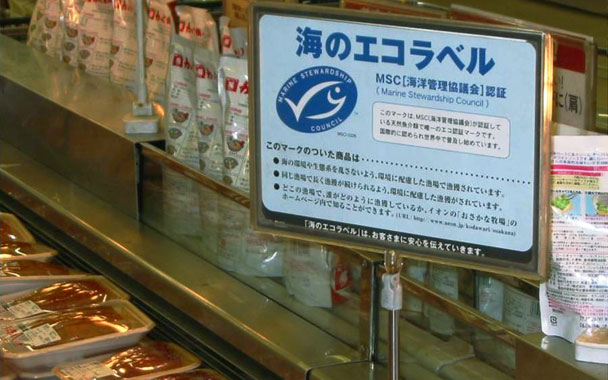In Tokyo supermarkets, rows of shrink-wrapped fresh seafood—including sockeye salmon, squid, mackerel, salmon roe, and tuna—compete for attention. You can buy packaged fish whole, splayed open, filleted, or in an endless assortment of sushi, the grab-and-go meal for harried Japanese homemakers.
At a supermarket I visited on the outskirts of the city, the fish counter was easily as large as the combined pork, chicken, and beef cases in your neighborhood Safeway. With so much fish for the taking, I wondered, what was left in the sea? Had Japanese shoppers even heard of sustainable seafood?
To find out, I met with Kozo Ishii, who opened the full-time Tokyo office of the Marine Stewardship Council (MSC) last year. The 11-year-old, London-based nonprofit organization works with fishermen and the trade to combat overfishing, illegal poaching, and bycatch by assessing current catches. If MSC finds that a fishery is managed responsibly, it slaps on its sustainable eco-label. There are 30 fisheries now certified and another 72 under assessment; most are in the U.S. and Europe, and others are in Vietnam, Australia, and eastern Russia.
Now that MSC has a foothold in Japan, Ishii’s job is to expand the sustainable seafood market in that country, not an easy task given the great culinary reputation of species like bluefin tuna and whale meat. Japan ranks as the largest seafood importer in the world and has the highest rate of per capita fish consumption, at 147 pounds a year. (Compare that to 17 pounds in the U.S.)
In America, chefs have led the charge for sustainable seafood (remember the “Give Swordfish a Break” campaign?), but supermarkets are leading the way in Japan. “A few retailers, especially the big ones, want to stay out in front on environmental sustainability,” Ishii said.
MSC wasn’t active in Japan, in fact, until pressed by a retailer to begin certifying its fish. Two years later, even though whaling and bluefin tuna auctions still grab the headlines, sustainable fish appears to be making quiet headway. Roughly 20 percent of Japan’s seafood imports are from sustainable sources, and the MSC label is found on 100 seafood products, including Alaska salmon and New Zealand hoki (which is commonly imported to the U.S. as fish sticks). Other popular imported species, such as Norwegian mackerel, are currently being assessed by MSC. And for the first time, two fisheries in Japan—snow crab and flathead flounder—are under review, although Ishii admitted that most Japanese fisheries have been harvested to oblivion.
The biggest problem continues to be the demand for tuna, much of it sold by sushi chain restaurants. “We have not met with them yet, but hope to,” Ishii told me. These chains aren’t selling the disappearing bluefin, which is found at $300-a-meal sushi bars, but the more common bigeye and yellowfin tuna.
As for pricey sushi bars, Ishii doesn’t expect any major shift toward more sustainable species. When I asked if he could name a top chef in the forefront of the sustainable-seafood movement, he was at a loss to come up with even one name. “I’m sure there is a chef out there,” he said, “I just don’t know of any.”



 Pinterest
Pinterest


